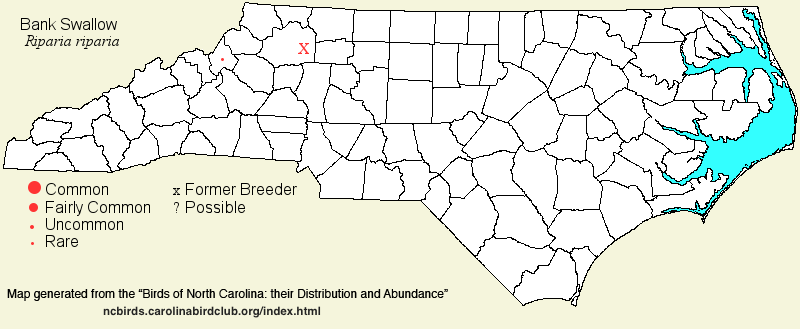 |  |
|
Bank Swallow - Riparia riparia HIRUNDINIDAE Members: | Search Common: Search Scientific: |
|
|
|||||||
| General Comments | The Bank Swallow has a range that not only encompasses most of North America (and wintering south to South America), it is also found in Europe, where it has the annoying name of Sand Martin. (We in the New World reserve the name "martin" for the larger swallows of the genus Progne, which are absent in Europe. Thus, there should be strong reasoning to keep this species as "Bank Swallow" if and when the time comes to standardize common/English names around the world.) North Carolina lies at the southeastern edge of the breeding range, and there have only been two confirmed nesting sites, one of which has now eroded away. They nest in taller banks than do the Northern Rough-winged Swallow, usually 20 feet or higher, and they nest in colonies (the latter species nests solely or in groups of two or three pairs). The sole remaining colony is (if still present) at a quarry in the mountains. Thankfully, the species does migrate over most of the rest of the state, so it passes through all counties annually, though in small numbers. Migrants are usually seen near fresh water -- reservoirs and natural lakes, and ponds -- frequently mixing with other swallows to sit on phone lines. | ||||||
| Breeding Status | Former Breeder | ||||||
| NC BRC List | Definitive | ||||||
| State Status | SR | ||||||
| U.S. Status | |||||||
| State Rank | S1B | ||||||
| Global Rank | G5 | ||||||
| Coastal Plain | Transient. In spring, generally uncommon (but as it occurs in flocks, can be sporadic from week to week) in the western portions, but generally rare to uncommon in the eastern portions; in fall, generally uncommon in the western portions, and fairly common more coastally. Mainly mid-Apr to late May, and mid-July to mid-Sep; absent by early Oct (no known records). However, there is one Nov record and several remarkable Dec records for a quarry at New Bern, in 1991 and 1993, with the latest date being 21 Dec. Peak counts: | ||||||
| Piedmont | Transient, and accidental (at least former) breeder. Nested along the Roaring River near Ronda (Wilkes) from 1977-78, with a maximum of 20 nest burrows [Chat 42:83-84 link]; however, this bank has eroded away, and thus the colony is long gone. Might possibly nest on occasions at one or two sites (Hyco Lake, Lake Gaston) near the VA state line. In migration, generally uncommon (though can be numerous on occasions) in spring across the region; in fall, slightly less numerous, but still uncommon. Mainly mid-Apr to late May, and late Jul to mid-Sep. Peak counts: | ||||||
| Mountains | Transient, and breeder (currently?) at one site. Rare to uncommon in both spring and fall. Nested at a quarry in Avery; first noted there in 1992, and last checked in 2007, when several pairs were seen. There have been no breeding evidence reported in the province since then. Mainly mid-Apr to late May, and late Jul to late Sep. One at Ecusta Pond (Transylvania) on 25 Mar 2023 was quite early. Peak counts: | ||||||
| Finding Tips |
As the quarry site is likely off-limits to birders, and likely is no longer active, one must stumble onto them in migration. The best places are some of the larger reservoirs, in the first half of May; or, near coastal impoundments or Tidewater lakes in Aug. ** | ||||||
| Attribution | LeGrand[2024-11-06], LeGrand[2023-08-10], LeGrand[2023-03-26] | ||||||
| NC Map Map depicts all counties with a report (transient or resident) for the species. | Click on county for list of all known species. |
| NC Breeding Season Map Map depicts assumed breeding season abundance for the species. |  |